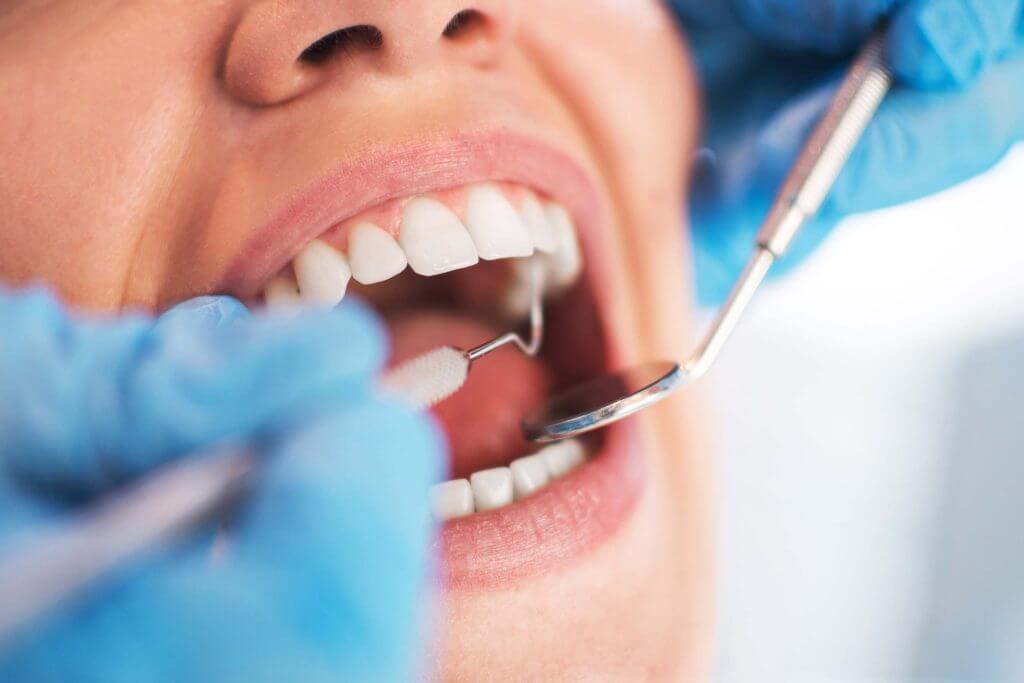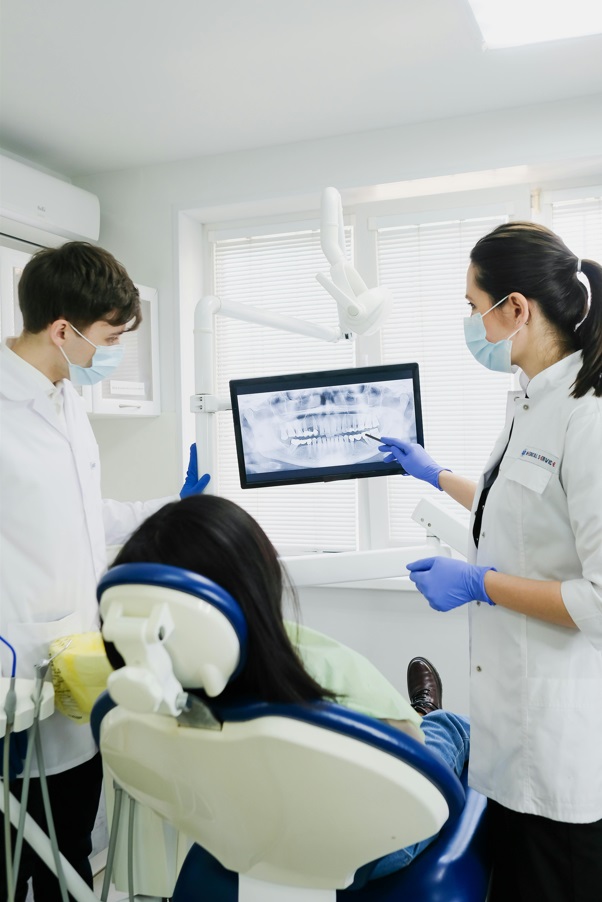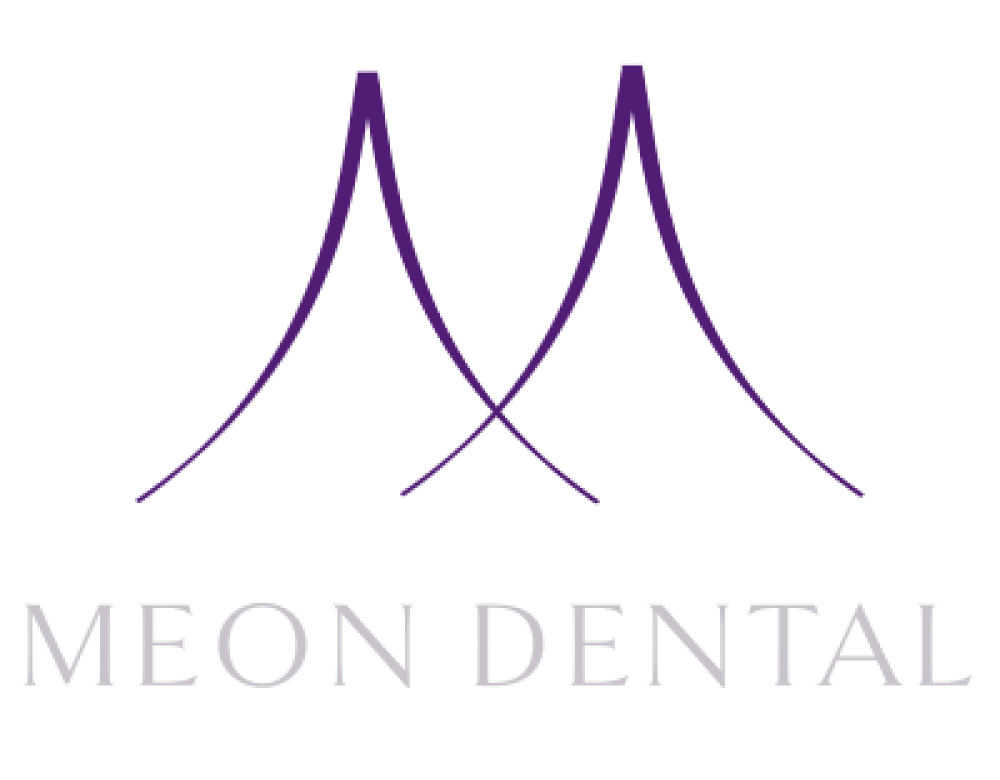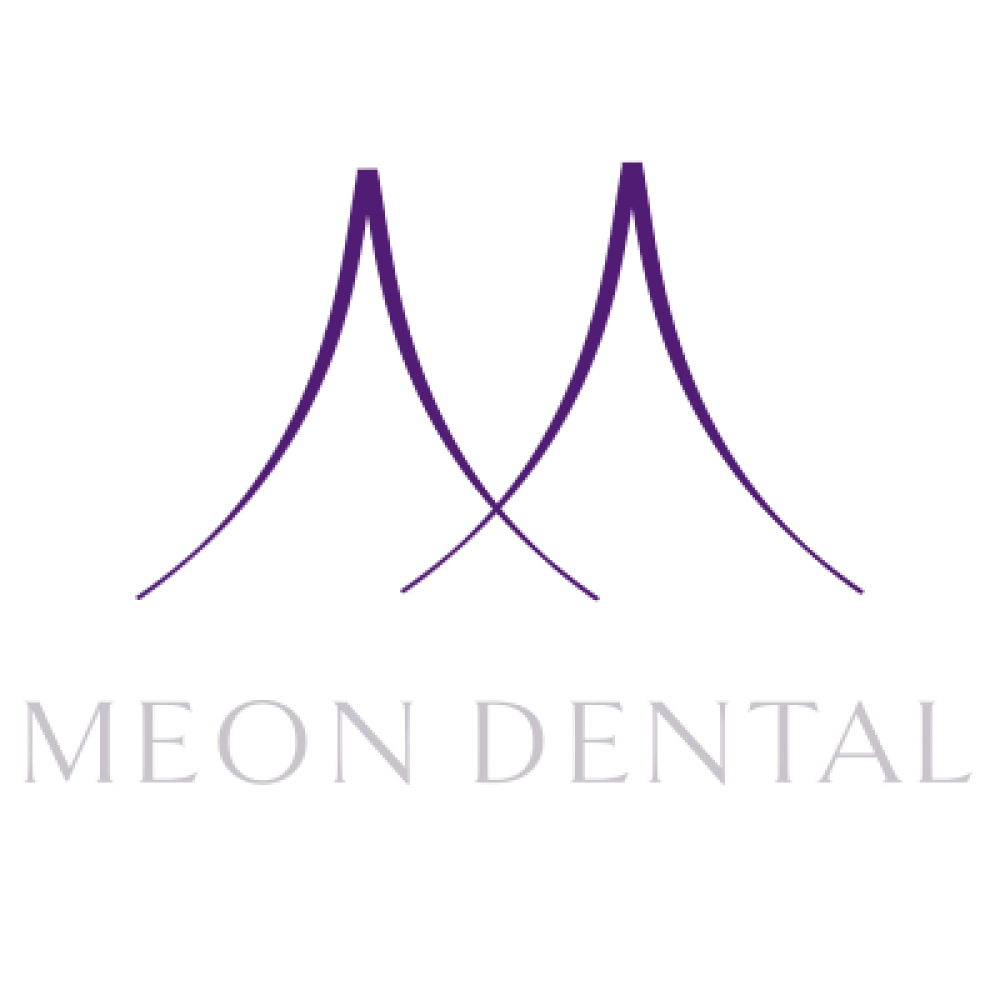DENTAL CROWNS & DENTAL BRIDGES
Is your natural tooth severely decayed, damaged or missing?
If yes, dental crowns and dental bridges are specifically for you. At Meon Dental, we offer a range of treatments for decayed, damaged or missing teeth. When you have your appointment with our dental team, we will take our time to examine your mouth to provide you with the best-suited recommendation.


What is a Dental Crown?
A dental crown, known as a dental cap, is specifically designed to cover and protect the remaining part of your tooth. Our dental crowns are a great solution to protect your teeth for the future using biocompatible materials, which give the most natural appearance using minimal-invasive and gentle techniques.
What a Dental Crown treatment involves?
Step 1
Firstly, we will prepare your tooth by clearing away decay and reshaping it so your bespoke crown can fit correctly.
Step 2
A scan will be taken of your shaped tooth, so our team can create a dental crown that will fit perfectly. While you wait for your dental crown to be made, a temporary one is fitted so your smile feels as natural as possible.
Step 3
You will then come back to get your permanent dental crown, where we will provide you with the right care you will need and recommend you book regular hygiene visits to look after your dental crown.
What is a Dental Bridge?
Are you missing one or multiple teeth?
Dental bridges may be the best solution for you, the treatment is a popular teeth replacement for a missing tooth or teeth.

What a Dental Bridge treatment involves?
Step 1
Once your dentist has examined if your teeth are suitable for a dental bridge; teeth on either side need to be healthy for the dental bridge to be held in place. Your neighbouring teeth will be prepared, by removing a little enamel.
Step 2
An impression is taken of your teeth and gums to get your dental bridge custom crafted to fit your smile.
Step 3
Your dental bridge is then fitted, giving you a long-lasting solution to your lost tooth or teeth. We do recommend you attend regular hygiene appointments to ensure your new bridge and neighbouring teeth remain strong and healthy.
Answers to Commonly Asked Questions Before Your Dental Crown & Dental Bridge Appointment
A dental crown is a covering that fits over your existing tooth to make it look and feel like a normal tooth. Crowns are often placed when a tooth is cracked or has lost its structure so that it can’t hold a filling.
You may need a dental crown if you experience any of the following: A crown can prevent a weak or loose tooth from damage or hold a cracked tooth together. Crowns can support and strengthen a broken or worn-down tooth. If you have advanced tooth decay, there may not be enough tooth remaining for a filling to be suitable. A crown may be needed to strengthen teeth and prevent further damage. Crowns can also cover teeth for cosmetic reasons, such as misshapen or severely discoloured teeth.
The number of appointments required for a dental crown can vary depending on several factors, including the complexity of the case and the specific treatment plan the dentist recommends. However, in general, the process typically involves two appointments:
First Appointment (Preparation Appointment): The dentist will prepare the tooth to receive the crown during this initial visit. This may involve removing decay or damaged portions of the tooth, reshaping it to accommodate the crown, and taking impressions or digital scans to create a custom-fitted crown. A temporary crown may also be placed to protect the prepared tooth while the permanent crown is being fabricated in a dental laboratory.
Second Appointment (Placement Appointment): At the second appointment, usually scheduled a few weeks later, the temporary crown, if placed, will be removed, and the permanent crown will be checked for fit, colour, and aesthetics. Once approved, the dentist will cement or bond the crown, making necessary adjustments to ensure proper bite alignment and comfort. In some cases, additional appointments may be necessary, such as if adjustments are needed to the crown or if complications arise during the process. However, the two-appointment process is the most common for dental crown placement.
If your dental crown feels loose or uncomfortable, it’s important to take action promptly to prevent further complications. Here’s what you should do:
Contact Your Dentist: Reach out to your dentist as soon as possible to schedule an appointment. Inform them about your situation and explain that your dental crown feels loose or uncomfortable. Your dentist will advise you on the next steps based on your situation.
Avoid Chewing on the Crown: Until you can see your dentist, avoid chewing on the side of your mouth with the loose crown. This can help prevent further damage or dislodgment of the crown.
Inspect the Crown: If possible, carefully inspect the loose crown to see if you notice any visible damage or if it has come completely off the tooth. Do not attempt to reattach the crown yourself, as this can cause more harm.
Keep the Crown Safe: If the crown has come off completely, try to keep it safe and clean. You can place it in a small container or plastic bag to bring it with you to your dental appointment.
Before your dental crown appointment, there are a few things you can do to prepare and ensure a smooth experience:
Eat a Meal: Depending on the timing of your appointment, it’s a good idea to eat a meal beforehand, especially if you’ll be receiving anaesthesia or if your appointment is later in the day.
Brush and Floss: Maintain good oral hygiene by brushing and flossing your teeth before your appointment. This helps ensure a clean mouth and may make the procedure more comfortable for you and your dentist.
Arrive Early: Plan to arrive a few minutes early for your appointment to allow time for check-in and any necessary paperwork.
Bring Necessary Items: Remember to bring your dental insurance information, identification, and any forms or documents requested by your dentist.
Prepare Questions: If you have any questions or concerns about the procedure, write them down beforehand so you can discuss them with your dentist during your appointment.
Arrange Transportation: If you are receiving sedation or anaesthesia during the procedure, arrange for someone to drive you home afterwards, as you may be tired or disoriented.
Taking these steps before your dental crown appointment can help ensure a successful and stress-free experience.
Generally, eating and drinking before a dental crown procedure is usually fine unless your dentist instructs explicitly otherwise. However, there are a few considerations to keep in mind:
Comfort and Convenience: Eating a light meal or snack before your appointment can help ensure you’re comfortable during the procedure and prevent hunger or low blood sugar levels.
Avoid Staining Foods and Drinks: If your dental crown is placed on a front tooth or in a visible area of your mouth, you may want to avoid consuming foods or drinks that could stain your teeth before your appointment. This includes coffee, tea, red wine, and highly pigmented foods like berries or tomato sauce.
Follow Dentist’s Instructions: If your dentist provides specific instructions regarding eating and drinking before your dental crown procedure, follow them carefully. Your dentist’s recommendations may vary depending on your situation and the type of anaesthesia or sedation used. If you need to decide whether to eat or drink before your dental crown appointment, it’s always best to consult your dentist for personalised guidance based on your specific needs and circumstances.
During the dental crown procedure, you can expect the following steps:
Preparation: Your dentist will start by numbing the tooth and surrounding area with a local anaesthetic to ensure you’re comfortable during the procedure. Once the area is numb, the dentist prepares the tooth for the crown. This may involve removing any decayed or damaged tooth portions and reshaping them to create a suitable foundation for the crown.
Impressions or Digital Scans: After the tooth has been prepared, your dentist will take impressions or digital scans of the tooth to create a custom-fitted crown. A dental laboratory will fabricate the permanent crown with these impressions or scans.
Temporary Crown Placement: While the permanent crown is being fabricated, your dentist may place a temporary crown to protect the prepared tooth and maintain its function and appearance. Temporary crowns are usually made from acrylic or stainless steel and are intended to be worn for a few weeks until the permanent crown is ready.
Fabrication of Permanent Crown: The impressions or digital scans taken during your appointment will be sent to a dental laboratory, where skilled technicians will fabricate your permanent crown. This process typically takes a few weeks.
Final Crown Placement: Once the permanent crown is ready, you’ll return to your dentist’s office for the final placement appointment. Your dentist will remove the temporary crown (if one was placed) and check the fit, colour, and aesthetics of the permanent crown. If any adjustments are needed, your dentist will make them before cementing or bonding the crown.
Bite Adjustment: After the crown has been cemented or bonded, your dentist will check your bite to ensure proper alignment and function. They may make additional adjustments to ensure your bite feels comfortable and natural.
Post-Care Instructions: Finally, your dentist will provide you with instructions on how to care for your new crown, including recommendations for oral hygiene, diet, and follow-up appointments. It’s essential to follow these instructions carefully to ensure the longevity of your crown and maintain good oral health.
Overall, the dental crown procedure is relatively straightforward and can usually be completed in two appointments. Your dentist will guide you through each step and ensure you’re comfortable and informed throughout the entire process.

A dental bridge is a dental prosthesis (artificial tooth) supported by two teeth on either side of a missing tooth. Dental bridges replace missing teeth which cannot be removed. The two teeth on either side of the missing tooth must be prepared for crowns. Dental bridges are custom-made to match the colour, shape, and size of the surrounding natural teeth, restoring the smile’s appearance and function. By filling in the gap left by missing teeth, dental bridges help improve chewing ability, speech clarity, and oral health while preventing neighbouring teeth from shifting out of alignment.
There are several types of dental bridges available, each designed to address specific needs and circumstances. The main types of dental bridges include:
Traditional Dental Bridge: Also known as a fixed bridge, this type of bridge consists of one or more pontics (artificial teeth) anchored in place by dental crowns or abutments attached to the adjacent natural teeth. Traditional bridges are the most common type and are suitable for replacing one or more consecutive missing teeth.
Cantilever Dental Bridge: Similar to a traditional bridge, a cantilever bridge uses dental crowns or abutments on only one side of the gap to support the pontic. This type of bridge is used when only one adjacent tooth is available for anchoring the bridge.
Maryland Dental Bridge: Also known as a resin-bonded or Maryland bridge, this type of bridge uses a metal or porcelain framework bonded to the backs of adjacent natural teeth with resin cement. Maryland bridges are a conservative option that preserves the structure of the adjacent teeth but may not be as durable as traditional bridges.
Implant-Supported Dental Bridge: Instead of relying on adjacent natural teeth for support, an implant-supported bridge is anchored in place by dental implants surgically placed in the jawbone. This type of bridge offers excellent stability and durability and is suitable for replacing multiple missing teeth or an entire arch of teeth. The choice of dental bridge depends on factors such as the location and extent of tooth loss, the condition of the surrounding teeth and tissues, and the patient’s oral health and aesthetic preferences. A dental professional can evaluate the individual’s needs and recommend the most appropriate type of bridge.
With porcelain finishes available, your new tooth could be almost indistinguishable from the natural teeth surrounding it. A dental bridge can boost your confidence with your smile and make daily activities such as eating and talking easier. Replacing a missing tooth can also help protect your remaining teeth.
During a dental bridge procedure, several steps are typically involved in designing, creating, and placing the bridge. Here’s an overview of what happens during the process:
Initial Consultation: The process begins with an initial consultation with a dental professional. During this appointment, the dentist will evaluate the patient’s oral health, discuss treatment options, and determine if a dental bridge is the most suitable solution for replacing missing teeth.
Preparation of Abutment Teeth: If the adjacent teeth serve as abutments for the bridge, they will be prepared by removing a small amount of enamel to accommodate the dental crowns. This step ensures a proper fit for the bridge and allows for the pontic (artificial tooth) attachment. Impressions: Impressions of the prepared teeth and the surrounding dental arch are taken to create a custom-made bridge that fits snugly and blends seamlessly with the natural teeth. These impressions serve as a blueprint for the fabrication of the bridge in a dental laboratory.
Temporary Bridge: While the permanent bridge is being fabricated, a temporary bridge may be placed to protect the prepared teeth and maintain aesthetics and function.
Fabrication of the Bridge: The dental bridge is fabricated in a dental laboratory using the earlier impressions. The pontic is crafted to match the natural teeth’ colour, shape, and size for a natural-looking result.
Placement of the Bridge: Once the permanent bridge is ready, it is carefully placed and secured in the mouth using dental cement or adhesive. The crowns or abutments are bonded to the adjacent teeth or implants to provide stability and support.
Adjustments: The bridge may be adjusted to ensure proper fit, bite, and alignment. Any necessary final touches are made to achieve optimal comfort and aesthetics.
Post-Placement Care: After the bridge is placed, the patient will receive instructions on how to care for their new restoration, including proper oral hygiene practices and dietary recommendations. Regular dental checkups are recommended to monitor the bridge’s and surrounding teeth’ health and function.
Overall, the dental bridge procedure is a multi-step process that requires careful planning, preparation, and execution to achieve a functional and aesthetically pleasing result. Working closely with a skilled dental professional ensures a successful outcome and restored oral health and function.
The lifespan of a dental bridge can vary depending on several factors, including the type of bridge, the materials used, the patient’s oral hygiene habits, and their overall oral health. On average, dental bridges can last anywhere from 5 to 15 years or more with proper care and maintenance. Traditional fixed bridges, supported by adjacent natural teeth, tend to last longer than Maryland bridges or cantilever bridges. Implant-supported bridges, anchored in place by dental implants, offer the highest stability and durability and can last for decades with proper care.
In the hours leading up to your dental bridge procedure, it’s essential to follow any specific instructions provided by your dental provider. While these instructions may vary depending on the individual and the nature of the procedure, here are some general guidelines to consider:
Medications: Follow any instructions regarding medicines provided by your dental provider. You may be advised to continue taking certain medications as usual, while others may need to be adjusted or temporarily stopped before the procedure.
Food and Drink: Depending on the anaesthesia or sedation used during the procedure, you may be instructed to avoid eating or drinking anything for a certain period before your appointment. Follow any fasting instructions your dental provider provides to ensure your safety and comfort during the procedure.
Hygiene: Practice good oral hygiene by brushing and flossing your teeth before the procedure. This helps minimise the risk of infection and ensures a clean oral environment for the dental provider.
Clothing: Wear comfortable, loose-fitting clothing to your appointment to help you feel more relaxed and comfortable during the procedure.
Transportation: If you receive sedation or anaesthesia during the procedure, arrange for someone to drive you to and from your appointment. You may be too tired to drive safely afterwards, so having someone available to assist you is important.
Arrival Time: Arrive at your appointment on time or slightly early to allow for any necessary paperwork or pre-procedure preparations.
Questions: If you have any questions or concerns about the procedure or your pre-operative instructions, don’t hesitate to contact your dental provider for clarification.
By following these guidelines and any specific instructions your dental provider provides, you can help ensure a smooth and successful dental bridge procedure.
Aftercare for a Dental Crown Treatment
Meon Dental prioritises your oral health and well-being even after your Dental Crown procedure. The essential aftercare is crucial to maintaining good oral health and prolonging the longevity of your Dental Crown.
We have prepared a comprehensive aftercare guide to assist you. Click here to see the Dental Crown aftercare guide:

